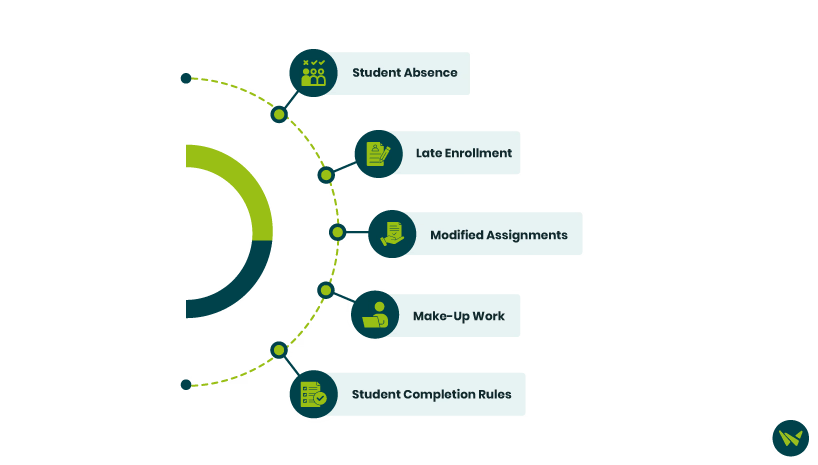
Schoology LMS offers multiple exception codes or rules that allow admins or teachers to apply exceptions to any assignment, discussion, assessment, test, or quiz. Within the Schoology gradebook, these exceptions help denote whether a student's submission is marked as absent, collected, incomplete, missing, or late.
One of these exception codes is ‘Exempt’. It is used to indicate that a student does not have to complete an assignment. When an item is marked exempt, it is removed from grade calculations, meaning it neither benefits nor harms the student’s overall grade.
IMPORTANT NOTE:
- Students can still choose to submit work for an exempted item if they wish
- New assignment notifications are still sent out even if an assignment is marked as exempt
Let’s take a detailed look at how the ‘Exempt’ status works in Schoology and how exemptions sync with different student information systems (SIS).

Here’s how you can apply and manage this feature in Schoology:
- Navigate to the ‘Gradebook’
- Hover over the gradebook cell where you want to add the exemption
- Click the ‘flag’ icon that appears
- Select ‘Exempt’ from the list of exception options
Key Notes:
- If you enter a score on an exempted item, the ‘Exempt’ flag is automatically removed
- If you add an exemption after a score has already been entered, the score will be cleared
- To enter a new score for an item that was previously excused, you must manually remove the ‘Exempt’ flag first
The ‘Exempt’ exception is helpful in situations where a student should not be required to complete an assignment, without it negatively affecting their overall progress or grade. Therefore, it should be used wisely in special cases when students can be excused without penalty.
Here are common scenarios when using this feature makes sense:
Student Absence
If a student misses an assignment due to illness or other valid reasons and completes an alternative task, the original assignment can be exempted to avoid penalizing the student for circumstances beyond their control.
Late Enrollment
New students joining a class after the start date can be excused from submitting earlier assignments. This helps them avoid getting penalized for missed work they couldn't complete due to their late enrollment.
Modified Assignments
Students with special education needs or accommodations may not be required to complete the same assignments as their peers. Excusing them from those tasks ensures their individual needs are met.
Make-Up Work
If a student completes a different project or method to make up for missed learning, the original assignment can be waived. This prevents confusion in grade calculations. Teachers may also choose to exempt assignments that are not critical to the course.
Student Completion Rules
Exempting assignments can bypass required materials under completion rules. For instance, if a student was absent and made up an assignment differently, this feature helps them skip certain steps without breaking the rules.
SIS | How Exempt Syncs |
PowerSchool | Passes back with an ‘Exempt’ flag and no score. No penalty for blank cells (treated the same as Schoology) |
eSchoolPLUS | Passes back as blank cells. You must select 'Exclude missing scores from average’ in eSchoolPLUS TAC to treat exceptions correctly |
Skyward | Passes back as blank cells. Clear the ‘Mark unscored as 0 and Missing' option to treat exceptions correctly |
Infinite Campus | Passes back with a Dropped status |
Aeries | Passes back with an ‘Exempt’ status |
SIS Connect | Passes back with an ‘Exempt’ status and a score of zero |
By using the ‘Exempt’ code thoughtfully, educators can ensure fair grading and flexibility. It enables students to stay on track without unnecessary penalties. And this is where we wrap it. If you need any further guidance, reach out to us today.
